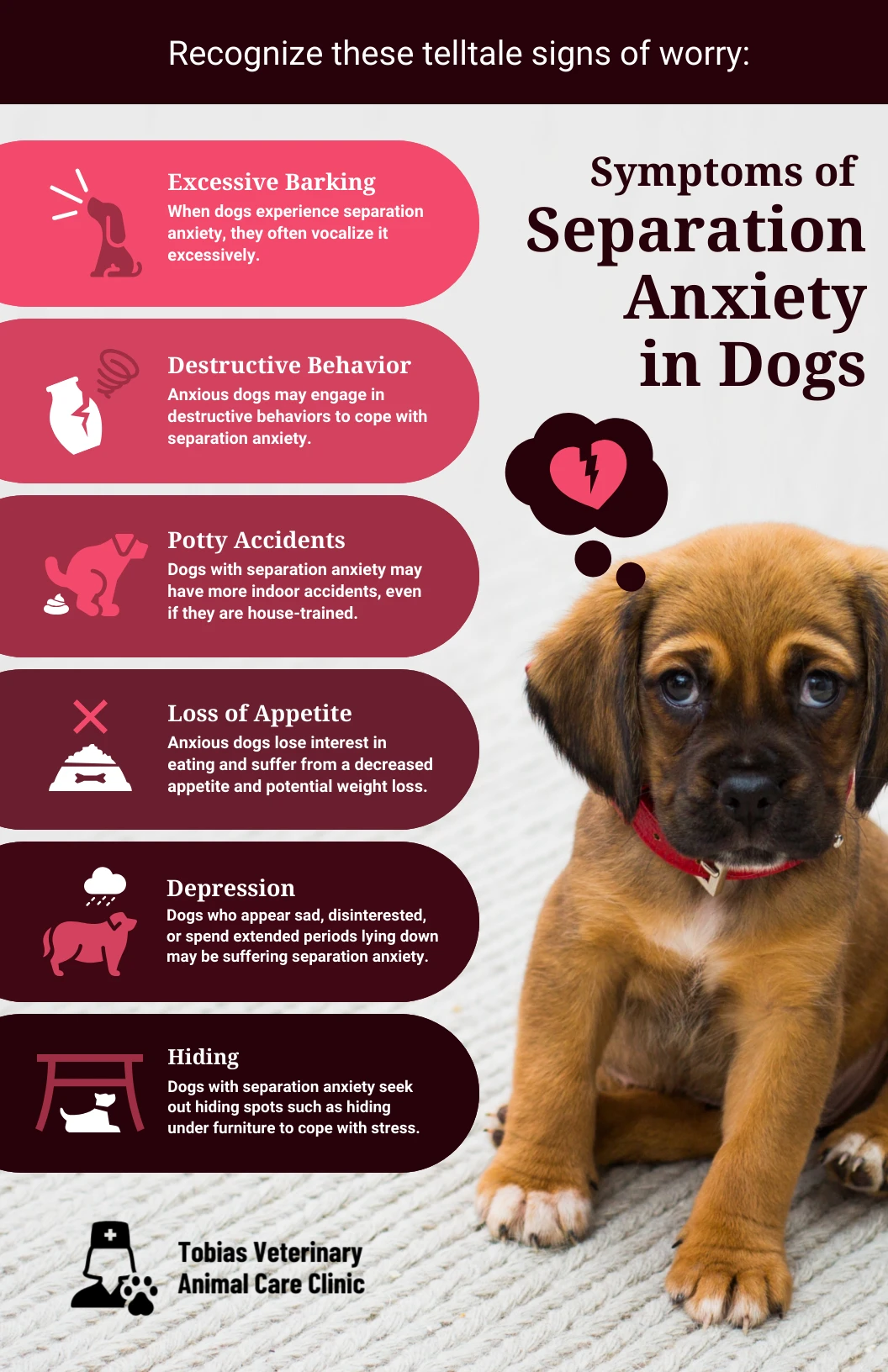Key Takeaways
Toys specifically designed to address canine separation anxiety can provide both mental stimulation and comfort for your dog.
Identifying the signs of stress in your dog is crucial in choosing the right anxiety-relief solutions.
Understanding the causes of your dog’s anxiety can help you select the best toys and strategies to alleviate their distress.
Creating a calm environment and establishing a routine are as important as choosing the right toys for your anxious dog.
Real-world examples and success stories can offer insight and assurance that these toys and techniques work.
“Symptoms of Separation Anxiety In Dogs …” from venngage.com and used with no modifications.
Fido’s Fear No More: Tackling Canine Separation Anxiety Head-On
When your dog watches you grab your keys, do they start to panic? Maybe they pace, whine, or even become destructive. It’s not just hard on them; it’s hard on you too. But here’s some good news: you can help your furry friend feel more secure, even when you’re away. Let’s dive into how you can turn your pup’s fear into fearlessness with the right toys and solutions.
The Tell-Tale Signs Your Pup Might Be Stressed
First things first, let’s spot the signs of separation anxiety. Does your dog do any of the following when you’re about to leave or while you’re gone?
Excessive barking or howling
Uncontrollable urination or defecation
Chewing, digging, or destruction
Pacing or restlessness
Attempts to escape
These behaviors are their way of saying, “I’m not okay with you leaving!” Recognizing these signs is the first step in finding a solution.
Understanding the Root: What Causes Your Dog’s Separation Woes
Why do some dogs suffer from separation anxiety while others don’t? It’s not always clear, but common factors include:
A change in routine or environment
A traumatic event, such as time spent in a shelter
Inadequate socialization or training
Naturally anxious temperament
Pinpointing the cause can guide you to the most effective solutions. For example, a dog who’s had a rough past may need extra comfort, while a pup with an anxious temperament might benefit from more mental stimulation.
Picking the Perfect Plaything: Toys That Tackle Anxiety
Now, let’s talk toys. The right toy can do wonders for a dog with separation anxiety. But not just any toy will do. You want something that will keep them engaged, comforted, and most importantly, calm.
Anxiety-Busting Activity Toys: Keeping Fido Busy and Relaxed
Activity toys are like puzzles for your pup. They require focus and problem-solving, which can distract your dog from their anxiety. Here’s what to look for:
Interactive toys that dispense treats as your dog plays with them
Durable chew toys that can withstand hours of gnawing
Puzzle toys that challenge their brain and tire them out mentally
Think about your dog’s personality when choosing these toys. A food-motivated dog might love a treat-dispensing puzzle, while a high-energy pup could benefit from a durable chew toy that keeps them occupied.
For example, the classic Kong toy, when stuffed with peanut butter or special treats, can keep a dog busy for hours as they work to get every last bit out.
Stay tuned for more insights on comforting stuffed toys and comprehensive solutions to ensure your dog’s happiness and well-being. Remember, a happy dog makes for a happy home.
Comfort Companions: Stuffed Toys That Soothe
Sometimes, what a dog really needs is a cuddle buddy. Stuffed toys can be more than just a soft plaything; they can act as a source of comfort for dogs that feel lonely. Look for stuffed toys that can take a bit of rough play, but also consider those with a heartbeat simulator or heat pack inside. These added features can mimic the feeling of snuggling up with a littermate, providing an extra sense of security.
More Than Just Toys: Holistic Solutions to Ease Your Dog’s Mind
While toys are a fantastic way to address separation anxiety, they’re just one piece of the puzzle. Creating a holistic plan means looking at your dog’s environment, routine, and overall health. By addressing these areas, you can create a comprehensive strategy that helps your dog feel more relaxed and confident, even when you’re not around.
Think about your dog’s space. Is it comfortable? Does it have a favorite blanket or bed? Is there somewhere they can go to feel safe? These considerations are crucial because they contribute to your dog’s overall sense of security.
Nutrition and exercise also play a vital role in your dog’s mental health. A well-exercised dog is typically a happy dog, and a proper diet can ensure they have the energy they need to stay healthy and the right balance of nutrients to support a calm mind.
Setting the Scene: Creating a Calm Environment at Home
To set the stage for a calm environment, consider the following:
Provide a dedicated ‘safe space’ for your dog with comfortable bedding and their favorite toys.
Use calming scents like lavender or pheromone diffusers designed for dogs.
Leave a piece of clothing with your scent near them to offer comfort.
Remember, your dog’s environment can significantly impact their anxiety levels. A calm and comforting space can make all the difference when it comes to their ability to cope with being alone.
Don’t underestimate the power of background noise. Leaving a radio on or playing calming music can help soothe your dog by masking the unsettling silence of an empty house.
Routine and Training: Building Confidence in Your Canine Companion
Establishing a consistent routine can help your dog understand what to expect each day, which can reduce anxiety. Include regular playtimes, walks, and quiet times in your dog’s schedule. Training is also crucial – practicing commands like ‘stay’ and ‘come’ can boost their confidence and help them feel more in control.
The Proof Is in the Pudding: Real Results from Anxiety-Alleviating Toys
Take Bella, a border collie with severe separation anxiety. Her owner introduced a treat-dispensing toy that kept Bella engaged for hours. The mental stimulation provided by the toy helped Bella focus on something other than her owner’s absence, reducing her anxiety significantly.
And then there’s Max, a rescue dog who found solace in a heartbeat toy. This simple stuffed companion offered him the comfort he needed to sleep through the night, even when his new family was out of sight.
These stories are not unique; they’re echoed by countless pet owners who have found that the right toy can lead to a happier, more content dog.
Chew on This: How Durable Dog Toys Make a Difference
Durability is key when it comes to toys for dogs with separation anxiety. These dogs often chew as a way to relieve stress, so you’ll want to provide them with toys that can stand up to their jaws. This not only ensures the toy lasts longer but also keeps your dog safe from ingesting broken pieces.
Smart Solutions: Interactive Toy Success Stories
Interactive toys have made a world of difference for dogs like Charlie, a labrador who used to tear up couch cushions out of anxiety. A smart puzzle toy redirected his energy and gave him a positive outlet for his stress. After a few weeks with the new toy, Charlie’s destructive habits decreased, and he was noticeably calmer when his owners returned home.
In conclusion, addressing canine separation anxiety is about finding the right combination of toys, environment, routine, and training. With these tools in hand, you can help your dog conquer their fears and live a happier life. Remember, every dog is different, so it might take some experimenting to find what works best for your furry friend. But with patience, love, and the right approach, you can make a significant difference in their well-being.
FAQ
Can a toy really help my dog with separation anxiety?
Absolutely. The right toy can be a powerful tool to alleviate your dog’s stress. It’s all about distraction and comfort. A toy that engages your dog’s senses and challenges their mind can prevent them from fixating on your absence. Think of it as a pacifier for pups; it’s there to soothe them when they need it most.
How long should I leave my dog alone with an anxiety toy?
The duration can vary based on the toy and your dog’s level of anxiety. As a general rule, you want to provide toys that are safe for unsupervised play. It’s also wise to rotate the toys to keep your dog interested. Start with short intervals alone with the toy, then gradually increase the time as your dog becomes more comfortable.
Are there specific breeds that benefit more from anxiety relief toys?
While any dog can experience separation anxiety, some breeds are more prone to it. Breeds known for their strong bonds with owners, like German Shepherds, Labradors, and Vizslas, may benefit greatly from anxiety relief toys. However, remember that individual personality is just as important as breed when it comes to anxiety.
How can I tell if a toy is successfully helping my dog’s anxiety?
Signs of success include a reduction in destructive behavior, less vocalization when you leave, and a calm demeanor when you return home. You might also notice that your dog starts to look forward to your departure because it means they get to play with their favorite toy.
What should I do if my dog doesn’t seem interested in anxiety toys?
Every dog is unique, and what works for one may not work for another. If your dog isn’t interested in a particular toy, don’t give up. Try different types of toys to find what piques their interest. Also, consider pairing the toy with treats or your scent to make it more appealing. Patience is key.
Remember, helping your dog overcome separation anxiety is a journey. It’s about finding the right mix of toys, training, and environmental changes. Keep experimenting and stay patient; you’re on your way to creating a happier, more peaceful life for you and your loyal companion.






